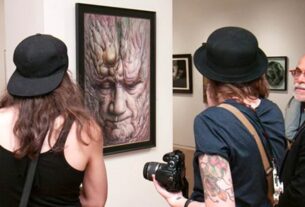The Benefit in the Trees can be a sculpture outdoors a history museum in Sydney Australia. 29 tall wooden rods representing trees are stuck randomly to the ground. Sooner or later 29 different groups of aboriginal people resided inside the Sydney area. The word what on the couple of from the rods will be the names of aboriginal people and places. Other rods have products of real human hair, covering, bone, lower and ash a part of them so when you walk incorporated within this you hear a soundscape of voices speaking in the Australian First Nations language referred to as Koori. Mobile phone Side of the Trees is certainly a creative representation in the The month of the month of january day in 1778 when the first quantity of ships filled with convicts and soldiers from Britain demonstrated in Sydney. The aboriginal people in the area might have viewed warily within the ‘edge in the trees or perhaps the ‘forest’ since these strange men and women came ashore.
Their wariness was ready. Initial contact involving the aboriginal and white-colored-colored cultures was disastrous for your Australian First Nations. The settlers introduced small pox, flu and measles germs together. The indigenous people did not have capacity these illnesses and whole tribes were decimated. Aboriginals were considered no a lot better than creatures by the majority of the first settlers and if you have been accounts of native people being hunted for sport. Between 1880 and 1969 more than one hundred,000 Australian aboriginal children were intentionally removed utilizing their parents to get switched into white-colored-colored Christians with the symptom in residential schools, adoptive homes or institutions. They are known australia wide since the Stolen Generation.

Two intriguing pieces within the Museum of latest Art in Sydney gave further knowledge of the bond forward and backward contrasting cultural groups australia wide. ‘Land Deal’ by artist Fiona Foley contained a massive spiral which were created on the floor in the museum from flour. On the wall behind it were about twenty hatchets, three dozen plain square items of mirror and an amount of knives and scissors. The amount of flour familiar with construct the spiral as well as the products in your wall symbolized just what the Wurundjeri people of Australia received with the British to acquire 600,000 acres from the land. Another Foley installation referred to as ‘Blankets’ contained seven grey government issue blankets while using British crown placed inside the corner. These blankets were traded while using First Nations people for land and frequently their women’s physiques. Each blanket features a different word written about it over and over. The word what are ‘Aboriginal’, ‘Women’, ‘Property’, ‘Defiled’, ‘Ravished’, ‘Shared’, ‘Discarded’. Grounds inside the museum program provided the extra information which sexually transmitted illnesses brought to Australia with the early settlers spread rapidly using the First Nations communities.
Several exhibits within the Natural History Museum of Australia highlighted hopeful modifications in aboriginal and white-colored-colored relations. A film with native elders telling ‘dreaming stories’ represents an attempt to preserve the standard legends and spiritual beliefs of First Nations people. A colorfully colored bus set up in the museum is really a employed by Australian Freedom Riders at the begining of 1960s. Duplicating whatever they saw happening inside the American South thirty students needed this bus to Australian aboriginal communities to stage protests because First Nations everybody was still being denied Australian citizenship. Their campaign received worldwide attention and so in 1967 aboriginal people acquired the legal right to election australia wide. The Commitment of Reconciliation may also be displayed inside the museum. Signed in May of 2000 it is a public apology with the Australian government for your wrongs implemented to First Nations people formerly.





